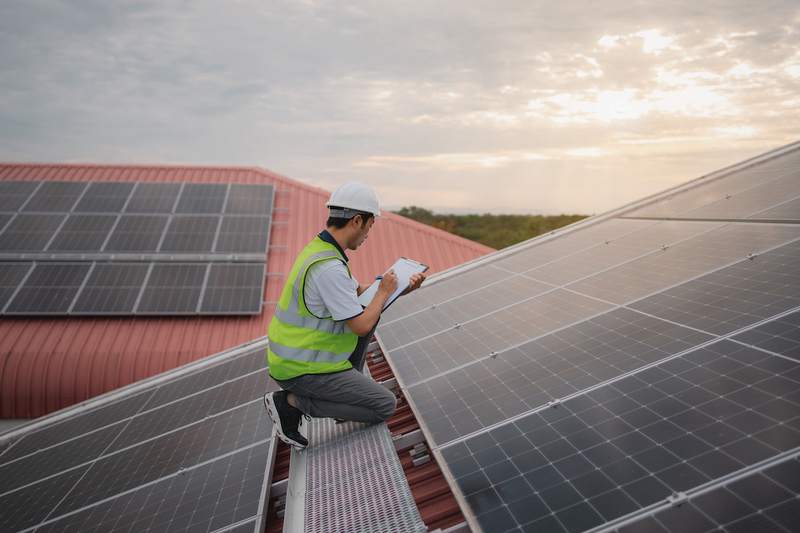Adding electricity-generating solar panels to your home can reduce utility costs and make your home more environmentally friendly. Installing solar panels also affects your home’s value — typically giving it a boost. But the size of the boost depends on where you live.
Key Takeaways:
- Solar panels can reduce monthly utility costs, boost home values, and be a draw for potential buyers.
- Many states have programs that prevent solar panels from increasing property taxes.
- Local rules for things like net metering have a big impact on the value of panels.
How Do Solar Panels Increase Property Value?
Every home uses electricity to power lights, appliances, computers, televisions, heating and cooling systems, and more. Adding solar panels to your home lets you generate electricity from sunlight, reducing or even eliminating the need to buy electricity from a utility. A home that costs less to power is more attractive to buyers than one that costs more.
A report from Zillow indicates that solar panels boosted the value of homes sold in 2020 and 2021 by 1.4%. For the median single-family home in the United States — which sold for $436,800 in the first quarter of 2023 — that translates to an increase in value of $6,115.20.
A 2015 study from the U.S. Department of Energy’s Lawrence Berkeley National Laboratory found that each watt of solar a home could generate added $4 to a home’s value in California and $3 elsewhere. That averages out to a $20,000 boost in value in California, and $15,000 in the rest of the United States.
Factors Affecting Solar Panels’ Value for Properties
Several factors influence how much value solar panels add to a property.
Cost
Installing solar panels isn’t cheap, but the cost has come down significantly over the past decade. The average cost of a solar panel installation — factoring in the federal solar tax credit — is between $17,340 and $23,870 in 2023, according to EnergySage, an online marketplace for solar energy. That’s down from a total of more than $50,000 just 10 years ago.
You’ll want to consider how much you need to spend to install solar panels when evaluating how much they may improve your home’s value.
Location
Where you live plays a major role in how much adding solar panels can affect home value. The more sunlight your home gets, the more power solar panels can generate, and the more value they add to your home.
Someone living in Phoenix, for example, will see an average of 3,870 hours of sun each year. Someone in Anchorage, Alaska, will see just 2,070 hours of sun. That means solar panels likely will add more value to a home in Phoenix than to one in Alaska.
Other location factors — such as how shaded your lot is and the direction your roof faces — also affect the value solar panels can bring to a home. Unshaded lots provide more solar potential, and south-facing panels tend to be more productive than panels facing other directions.
Local electricity rates
The value of solar panels comes from their ability to generate electricity, reducing the amount you need to buy from a utility. If electricity is expensive in your area, expect solar panels to increase your home’s value more than they would in an area where electricity is less expensive.
For example, people in Miami pay an average of 16.3 cents per kWh of electricity, while people in Boston pay an average of 32.8 cents per kWh. That means Boston homeowners get nearly twice as much value for every kilowatt-hour a solar panel produces.
Urban Hawaii is the priciest area for electricity, averaging 40.5 cents per kWh. The cheapest is St. Louis, where prices average 13.2 cents per kWh.
Condition of your solar energy system
As with anything in a home, the condition of the solar panels affects their value. Panels that are brand-new, well maintained, and producing power at their maximum capacity are worth more than panels that need maintenance and are producing less power.
The average life span of a solar panel is 30 to 35 years, meaning it will be with your home for the long haul.
Solar market
The local solar market also plays a role in how much value adding panels can increase your property value. States that encourage the growth of the solar power market with incentives and rebates offer greater potential for homeowners to increase their property values with solar panels.
According to the Solar Energy Industries Association, the states with the top 10 solar markets through 2022 are:
- California.
- Texas.
- Florida.
- North Carolina.
- Arizona.
- Nevada.
- Georgia.
- New Jersey.
- Virginia.
- New York.
Owning or leasing
While many people buy their solar panels outright, it’s not unusual to lease them.
Leasing solar panels means you contract with a company that installs the panels on your home. The company owns the panels, and you as the homeowner lease them for a fee and can use the electricity they generate.
The advantage is that no upfront fees are required, and it saves you money as long as what you’re paying to lease the panels is less than your savings from using the power they generate.
The disadvantage is that the terms of solar leases often can be complicated. Because of that, leased panels add far less value to a home than panels that are fully bought and paid for, and can deter potential buyers, says Cy Yablonsky, co-founder of PowerLutions Solar, a solar panel installation company based in Lakewood, New Jersey.
One option for handling a lease when selling is to transfer the lease to the buyer. However, not all buyers will want to take on the lease.
You also could buy out the lease before selling, but it can be expensive, and recouping that cost depends on finding a buyer willing to pay enough for the home to compensate you.
How Solar Panels Affect Property Taxes
Increasing your home’s value often means an increase in your property tax bill. If adding solar panels boosts your property value, it can be reflected in your next assessment. For example, if you pay 2% property tax on a $200,000 home and its value rises to $215,000, then you’ll owe an extra $300 per year.
How often your home’s value is reassessed — and how much value the assessor credits to the solar panels — varies widely from state to state, county to county, and city to city.
However, some states want to encourage homeowners to install solar panels, and enact exemptions and incentives when it comes to assessment for property taxes. For example, Massachusetts ignores solar panels when assessing home values for 20 years after installation.
Getting the Most Value From Your Solar Panels
If you’re thinking about adding solar panels to your home, you also should try to get the most value possible from them.
Proper system sizing
It’s important to buy a solar panel system that is the right size for your home and how much energy it uses. A system that’s too small will mean missing out on potential savings, while one that’s too large could mean you’re paying for panels you don’t need.
“Make sure any system you have put on produces a 100% offset. This will allow you to reduce your electricity cost and only pay your solar loan,” says Neil Gallagher, vice president of Brighterway Solar, a Bartow, Florida-based installer. If you decide to buy rather than finance your panels, you can eliminate most of your electricity costs after paying for the installation upfront.
It’s also a good idea to plan ahead. You may want to increase your generating capacity at some point if you plan to buy an electric car or an electric heating or cooling system.
Another thing to consider, according to Gallagher, is making sure your appliances are energy efficient.
“The more energy you can save, the more beneficial your system will be,” he says.
Incentives, credits, and rebates
Incentives, credits, and rebates play a significant role in reducing the price of installing solar panels.
One of the best credits available is the federal tax credit for installing solar panels. When you install solar panels, you can claim a tax credit for 30% of the cost. That credit directly reduces how much you pay in income tax, effectively knocking 30% off the price of your system.
For example, if you install solar panels at a cost of $20,000, you can claim a tax credit for $6,000. That makes the effective cost of the system $14,000.
Note that this credit isn’t refundable, so you’ll need to owe at least that much in tax to get the full benefit.
There are other programs available as well. Some utilities offer rebates to help people pay for the installation of solar panels. Many states also offer tax credits or incentives. For example, Hawaii offers a 35% tax credit, up to $5,000, for installing solar panels.
Net metering
Solar panels make electricity from sunlight. When the sun goes down, your panels stop generating power, and you need another source until sunrise.
That’s where net metering comes in, and it’s a big part of the value added by installing solar panels.
Here’s how it works: When your panels are producing more power than you’re using, your home will export that extra electricity to the utility to be used elsewhere. When the panels aren’t making enough power to run your home, you’ll pull electricity from the utility. Net metering tracks your net use of grid power — taking the amount you use and subtracting the amount you export to the grid.
Precisely how net metering works can be complicated, depending on where you live.
Some states make it simple. Your utility simply tracks your net usage. If you import more than you export, you pay for the net amount imported. If you export more than you import, you get a credit on your bill for the net amount exported.
In other areas, the price of electricity varies with the time of day, and you might get credit for exporting power at a different rate than you pay for importing power. Other states don’t net meter at all, and just pay a flat rate for excess production.
Solar batteries
Many homeowners install battery systems as part of their solar energy system. Battery systems store excess power generated by solar panels. This power can be used at night or other times when there’s insufficient light to generate power, as an alternative to utility-generated power.
Batteries can keep your home running when the power goes out in your neighborhood. Another advantage is that batteries can help you take advantage of time-of-use rates for electricity. For example, you could charge the battery during daylight hours when electricity is inexpensive, and run your home off battery power during high-demand evening hours to reduce or eliminate the need to buy utility power when it’s most expensive.
There are tax incentives available for battery installations that can reduce the price of installing these systems.
Solar Panels FAQ
Here are answers to some common questions about whether solar panels increase home value.
How long it takes to recoup the cost of installing solar panels depends on how much you pay for the system, how much energy the panels produce, the price of energy in your area, how much electricity you use, and local rules around net metering. In short, it’s complicated. According to EnergySage, most homeowners break even in about eight to nine years.
The size of your system and how much sun your home gets will determine how much electricity you can generate with solar panels. Most modern panels have output ratings of 250 to 400 watts. To find the approximate production of a panel, multiply its output rating by the average number of sunlight hours your home gets. For example, in an area that gets about 12 hours of sunlight per day, a 300-watt panel will produce an average of 3.6 kWh per day.
Many solar systems are mounted on roofs, so it’s understandable to worry about damage. Properly installed solar panels won’t damage your roof and may even help protect it from the elements. However, the panels will add weight, which can cause your roof to deteriorate more quickly. Overall, if the system is installed and maintained well, it should not affect your roof’s life span.
The Bottom Line on Solar Panels and Property Value
Solar panels can help you reduce electricity costs by generating your own power, which also can add value to your home. Look into how your utility company handles things like net metering, as well as local incentives, to figure out how to get the most value out of solar.






